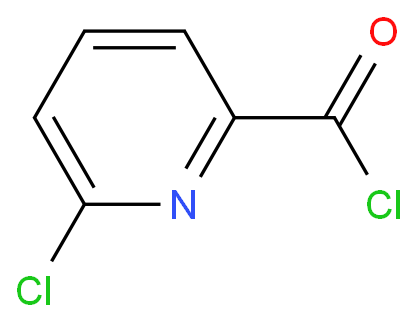
|
To 20 g (144 mmol) of 6-hydroxypicolinic acid were added 50.6 g (330 mmol) of phosphorus oxychloride and 99.8 g (479 mmol) of phosphorus pentachloride, and the mixture was stirred at 90° C. for 8 hours. [0325] After cooling, 8.6 g of formic acid was added to the mixture, and the resulting mixture was concentrated by an evaporator to obtain the desired compound 6-chloropicolinic chloride quantitatively.6-Chloropicolinic Acid Chloride Analogously to Example 1, 100 g of 6-hydroxypicolinic acid was chlorinated to After distilling-off of the phosphoroxy chloride, Preparation of 2-chloro-6-pyridinecarbonylchloride [Az = 2-chloro-6-pyridyl in the compound of formula I] A mixture of 200 mmol Nitrapyrin (2-chloro-6-trichloromethylpyridine) with the given amount of the catalyst is heated to temperatures between 90 and 130 C. 200 mmol of the organic acid was dosed into the mixture under reduced pressure. The organic acid chloride formed by the reaction was distilled off during the reaction time. The reaction was monitored by GC analysis. The product is obtained by conventional work-up and distillation under reduced pressure as colorless crystals and shows the following physical properties: mp 74-75C, bp 80C/2.6 Pa 1H-NMR (DMSO, 300 MHz): delta (ppm) = 8.11 (m, 2 H, 3-, 5-CH), 7.80 (m, 1H, 4-CH). 13C-NMR (DMSO): delta (ppm) = 164.7 (q, COCl), 150.2 (q, 6-C), 148.8 (q, 2-C), 141.0 (t, 4-C), 127.9 (t, 3-C), 124.0 (t, 5-C).6-chloro-pyridine-2-carboxylic acid (4.4 g, 27.9 mmoles, 1 eq.) was placed under an inert atmosphere of argon. Thionyl chloride (8.1 mL, 111.6 mmoles, 4 eq.) was slowly added. The reaction mixture was heated at reflux and stirred for 48 hours. Upon cooling to room temperature, the reaction mixture was concentrated under reduced pressure. N, N-Diethylpropylenediamine (2.5 mL, 15.7 mmoles, 1.1 eq.) was placed in a 3N NaOH aqueous solution (20 mL) and dichloromethane (10 mL) was added to the solution. The reaction mixture was cooled down to 0C with an ice bath and a solution of the

|

|

|

|

|

|

|

|